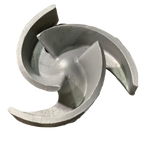In the late 1960s, Stainless Foundry & Engineering (SF&E) was one of the top producers of impellers in North America. More than 50 years later, impellers remain our top produced part, along with other crucial pump and valve components. In honor of our Top 6 most produced parts, we’ve collected the Top 6 ways to get ahead and stay ahead in the foundry industry.
1. Do something no one else is doing. SF&E’s high-level status in the 1960s was because of a sand technique we developed that was superior to our competitor’s offerings. For impellers, it’s all about the mold. The SF&E technique produced a smooth surface finish inside the impellers. A smooth surface finish is especially important for closed impellers, which can be difficult to clean when clogged. For many original equipment manufacturers (OEMs), the SF&E sand technique made all the difference.






